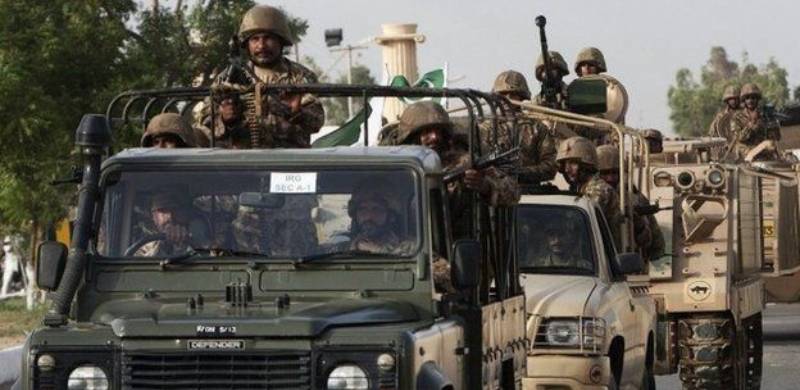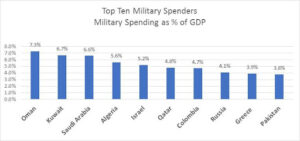
The subject of Pakistan’s military spending has been in the news after the government increased the defence budget for the outgoing fiscal year by nearly 6% to “reportedly” over Rs1.45 trillion. Some analysts have compared this to India’s military spending and argued that it was “low”.
How does one determine whether a military budget is low or not too high? How does one evaluate? One must have a rational basis to make that statement. Do these analysts know the real defence budget including its tax implications? Do they know the opportunity cost of resources diverted to military enterprises at below-market prices?
Let’s start with some basic facts. Pakistan’s defence budget during 2021-22 was almost Rs2.3 trillion and not the commonly reported figure of Rs. 1.37 trillion (now revised to Rs.1.45 trillion). The Rs2.3 trillion is based on the official budget documents and its breakdown is as follows:
Based on an average exchange rate of Rs175 to a U.S. dollar, Pakistan's military spending was $13.3billion or about 3.8 per cent of the gross domestic product or GDP.
According to Stockholm International Peace Research Institute (SIPRI), India’s military spending of $76.6 billion (at 2.7 per cent of its GDP) ranked third highest in the world. However, this needs to be put in context. India views China, not Pakistan, as its principal economic and military rival. India is more than twice Pakistan’s size in the territory with upwards of 13,000 sq. km in land boundaries to Pakistan’s 7,257 sq. km, and a coastline of about seven times more. India’s economy, with a GDP of $2.8 trillion) is almost eight times larger than Pakistan’s. Pakistan’s highest ever foreign exchange reserves have been $27 billion, less than 5% of India’s current level of foreign exchange reserves of $600 billion.
India’s military spending was just 26 per cent of China’s spending of $293 billion or 1.7 per cent of its GDP. It is important to stress that the most relevant and widely used criteria for measuring military spending is its level compared to the size of its economy or its GDP. Based on this measure, Pakistan’s rank is the tenth globally as shown in the graph:

Hence, although the absolute numbers may show a rising trend, global military spending as a percentage of GDP declined slightly to an average of 2.2 per cent in 2021, compared with 2.3 per cent in 2012. Israel has been a notable exception. Although its current military spending is around 5.2% of its GDP, this ratio has shown a declining trend over decades. For example, it was 11.5% in 1993.
India’s corresponding ratio has ranged between 2.5 to 3 per cent of the GDP for the past twenty years. In Pakistan’s case, the lack of transparency makes it difficult to comment on the appropriate level of defence spending as even the basic data is hidden under different heads, not to mention the prominent role played by the military in the overall political economy.
How does one determine whether a military budget is low or not too high? How does one evaluate? One must have a rational basis to make that statement. Do these analysts know the real defence budget including its tax implications? Do they know the opportunity cost of resources diverted to military enterprises at below-market prices?
Let’s start with some basic facts. Pakistan’s defence budget during 2021-22 was almost Rs2.3 trillion and not the commonly reported figure of Rs. 1.37 trillion (now revised to Rs.1.45 trillion). The Rs2.3 trillion is based on the official budget documents and its breakdown is as follows:
| Rs. Billions | |
| Defence Services (Revenue budget) | 1453.0 |
| Pensions (Revenue Budget) | 360.0 |
| Armed Forces Development Programme* | 340.0 |
| Civil Armed Forces | 136.8 |
| Atomic Energy Commission | 27.0 |
| Cantonment Boards | 6.9 |
| Defence Division (Revenue a/c) | 3.5 |
| Defence Division (PSDP**) | 2.0 |
| Defence Production (PSDP**) | 1.7 |
| 2330.9 | |
| * Reported as grant, not expense | |
| ** Public Sector Development Programme |
Based on an average exchange rate of Rs175 to a U.S. dollar, Pakistan's military spending was $13.3billion or about 3.8 per cent of the gross domestic product or GDP.
According to Stockholm International Peace Research Institute (SIPRI), India’s military spending of $76.6 billion (at 2.7 per cent of its GDP) ranked third highest in the world. However, this needs to be put in context. India views China, not Pakistan, as its principal economic and military rival. India is more than twice Pakistan’s size in the territory with upwards of 13,000 sq. km in land boundaries to Pakistan’s 7,257 sq. km, and a coastline of about seven times more. India’s economy, with a GDP of $2.8 trillion) is almost eight times larger than Pakistan’s. Pakistan’s highest ever foreign exchange reserves have been $27 billion, less than 5% of India’s current level of foreign exchange reserves of $600 billion.
India’s military spending was just 26 per cent of China’s spending of $293 billion or 1.7 per cent of its GDP. It is important to stress that the most relevant and widely used criteria for measuring military spending is its level compared to the size of its economy or its GDP. Based on this measure, Pakistan’s rank is the tenth globally as shown in the graph:

Hence, although the absolute numbers may show a rising trend, global military spending as a percentage of GDP declined slightly to an average of 2.2 per cent in 2021, compared with 2.3 per cent in 2012. Israel has been a notable exception. Although its current military spending is around 5.2% of its GDP, this ratio has shown a declining trend over decades. For example, it was 11.5% in 1993.
India’s corresponding ratio has ranged between 2.5 to 3 per cent of the GDP for the past twenty years. In Pakistan’s case, the lack of transparency makes it difficult to comment on the appropriate level of defence spending as even the basic data is hidden under different heads, not to mention the prominent role played by the military in the overall political economy.

